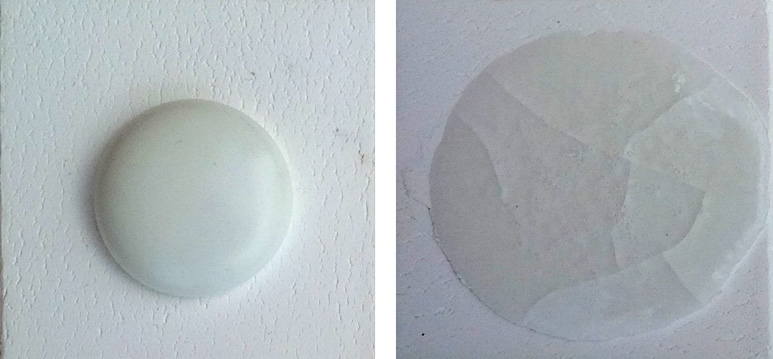| Monthly Tech-Tip | No tracking! No ads! |
These two frits have one difference in the chemistry: Al2O3.
These two boron frits (Ferro 3124 left, 3134 right) have almost the same chemistry. But there is one difference: The one on the right has no Al2O3, the one on the left has 10%. Alumina plays an important role (as an oxide that builds the glass) in stiffening the melt, giving it body and lowering its thermal expansion, you can see that in the way these flow when melting at 1800F. The frit on the right is invaluable where the glaze needs clay to suspend it (because the clay can supply the Al2O3). The frit on the left is better when the glaze already has plenty of clay, so it supplies the Al2O3. Of course, you need to be able to do the chemistry to figure out how to substitute these for each other because it involves changing the silica and kaolin amounts in the recipe also.
Videos
Links
| Oxides | Al2O3 - Aluminum Oxide, Alumina |
| Oxides | B2O3 - Boric Oxide |
| Materials |
Ferro Frit 3124
A commonly available calcium borosilicate frit. |
| Materials |
Ferro Frit 3134
A frit with 23% B2O3. The most common of frits used in pottery in North America. Around the world, other companies make frits of equivalent chemistry. |
| Articles |
What Determines a Glaze's Firing Temperature?
The oxides contributed by glaze materials determine its chemistry. The chemistry is the main factor determining melting behaviour. But the particle sizes, shapes and mineralogies also come in to play. |
| Glossary |
Glaze Chemistry
Glaze chemistry is the study of how the oxide chemistry of glazes relate to the way they fire. It accounts for color, surface, hardness, texture, melting temperature, thermal expansion, etc. |
Got a Question?
Buy me a coffee and we can talk

https://digitalfire.com, All Rights Reserved
Privacy Policy

